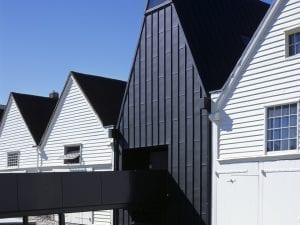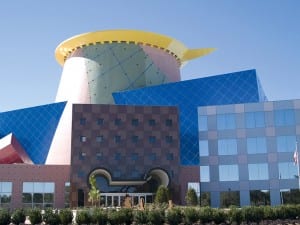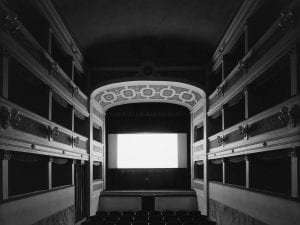“All cultures are a mirror to understanding myself and all things”
Shirazeh Houshiary’s current exhibition at the Lisson Gallery will be her sixth solo show with Lisson and her first project in their new exhibition space; an exciting prospect to the artist, who confirms, “it’s challenging when you don’t know the space” and something which feeds the creative process. Running until 26 July 2008, the exhibition incorporates seven new large-scale paintings, a body of towers and Houshiary’s first film-based work, Shroud 2007.
Born in Iran, Houshiary has lived in London since studying at the Chelsea School of Art in the 1970s. With work already in major collections such as MOMA and the British Council Collection, her pieces are increasingly spreading into public places with site-specific installations in Battery Park, New York and Midtown Tokyo.
The current exhibition at the Lisson Gallery comprises a variety of mediums to convey a simultaneous message. For Houshiary, each medium leads onto the next, creating a dialogue between forms, she relishes that “every time I have to invent, to vision in a new language.” The works with which she feels most connected are inevitably her paintings, which comprise delicate, meticulous pencil work on a more robust aquacryl. From these ideas, animations, sculptures and towers grow. On her interdisciplinary approach Houshiary says, “I like the fact that the same idea, the same vision, can be interpreted in many different ways.”
This open-minded approach is reflected when initiating projects; “everything inspires me, from nature to different cultures to the arts.” For Houshiary “inspiration comes from everywhere.” Having previously eschewed categorisation and a restriction to one form she is keen to avoid overt alliance to any one school of thought and seeks to transcend binary identities such as nationality, race or religion especially in light of accelerating globalisation — “more than ever before we are linked. What is a particular nationality? How can we define these things?” These questions inform Houshiary’s opinion that art cannot be pigeonholed into descriptions of Iranian, Christian and the like. Her works appeal to a common vein in humanity and everyone can take their own interpretation from them because her pieces reflect our universality. Above all other things, this common humanity informs her work. “The only thing that I relate to is that I’m a member of human consciousness and that’s why all cultures are a mirror to understanding myself and all things.”
Houshiary continues her ten-year collaboration with architect, Pip Horne, for a six-and-a-half-metre sculptural tower made of anodised blue aluminum in the Lisson’s outdoor space and an additional two towers measuring three metres each, one pink and one turquoise. The prospect of working with others is nothing new to Houshiary. It is a process, which is always “very inspiring and exciting”, and something which she actively seeks, to enable others’ expertise to realise her works in new material forms. One such example can be found in the exhibition’s computer animation, Shroud, created with the assistance of Mark Hatchard. Houshiary makes it clear, however, that her work with Horne is a joint creative process rather than a mere technical alliance, saying: “We worked together to make it work.”
The pair also collaborated on the recently unveiled East window of St Martin’s-in-the-Fields, London, so Horne “could relate to the architecture and the surrounding area” while Houshiary’s painting provided the impetus. The St Martin’s project created a new challenge for Houshiary as its religious nature seems to initially contest her non-binary opinions on life and religion. The window, a distorted reflection of a cross as seen in water, shows that Houshiary has embraced the opportunity to really challenge society’s binary conceptions of religious art by bringing back the “essential meaning” of religion, “connecting back to one’s essence.” The proprietors of St Martin’s-in-the-Fields share Houshiary’s sentiments — when she was commissioned to do the piece it was clear that “as long as it had a spiritual dimension” the piece didn’t need to be specifically Christian. On religion, Houshiary is ambivalent, returning back to her all-encompassing inspirations: “When you touch humanity in its essence it all connects, it’s one.” In refusing to be religion specific the St Martin’s-in-the-Fields window provides a clear continuity with the church’s general ethos, it is a space for all, with its adjoining soup kitchen, parish meeting rooms and Chinese community centre, not just for a select few. Houshiary is excited at the privilege of reaching out beyond the usual gallery attendees and sees the window as a welcome for people of all faiths — “all the particular religions can be found in it because you are touching the whole not the fragment.”
The excitement of reaching many outside of the arts community is not lost on Houshiary who says of the St Martin’s window, “I was so moved at how many people from different fields of life have to deal with this.” As such a prolific public building, the St Martin’s window will remain for years to come and may prove to be Houshiary’s legacy, while providing further inspiration for the artist; “it’s a fantastic opportunity for any artist to test themselves.”
Houshiary exhibited alongside Spencer Finch in 2008. www.lissongallery.com.
Pauline Bache





